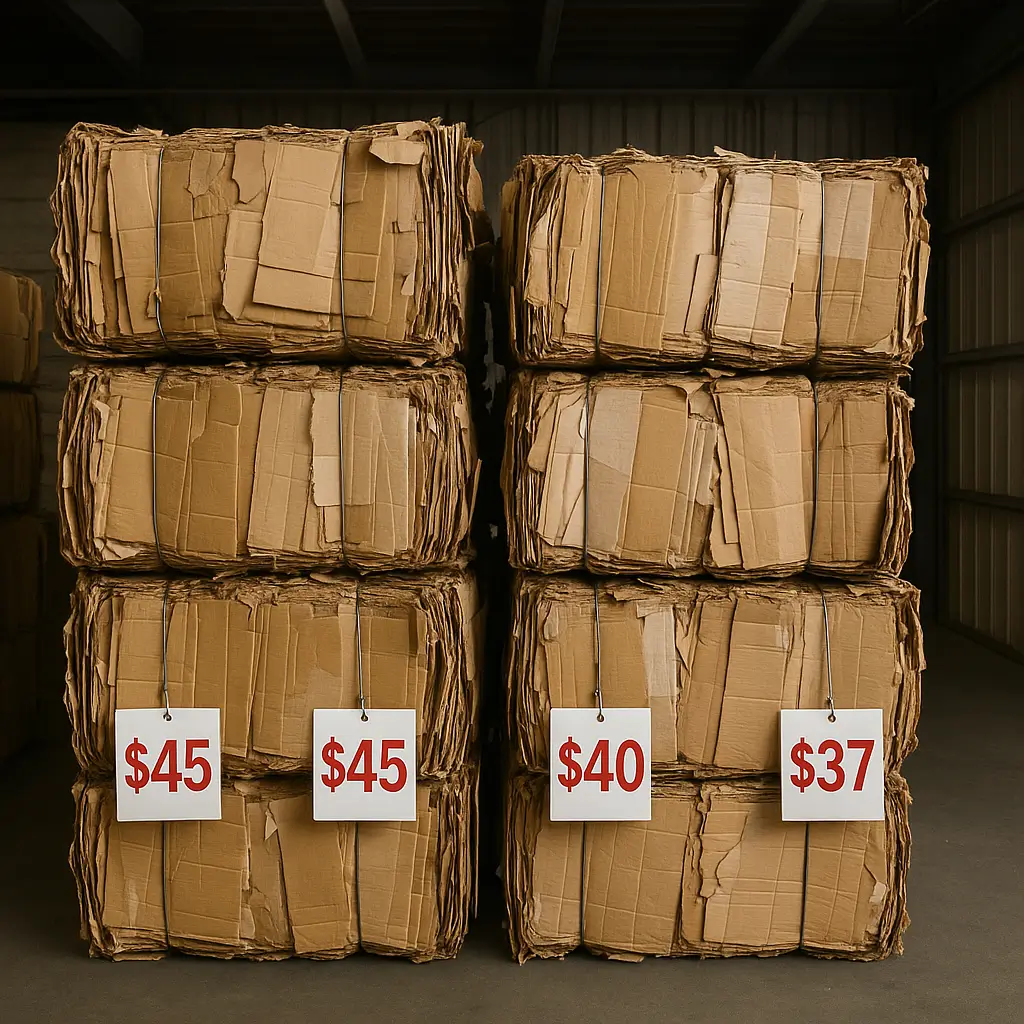Key Takeaway: A standard cardboard bale, weighing between 800 and 1,000 lbs (0.4–0.5 ton), is currently worth approximately $20 to $95 per bale in the U.S. market—equating to $40–$190 per ton—with prices influenced by regional demand, bale quality, market trends, and transportation costs. Understanding these factors is essential for maximizing revenue from cardboard recycling and optimizing waste-management strategies.
1. Typical Bale Specifications and Weight
Cardboard bales are compacted, uniform bundles of corrugated cardboard formed by hydraulic balers. Industry standards vary by machine type:
- Vertical Balers (Mill-Size Bales):
- Dimensions: ~60″ × 30″ × 42″
- Weight: 800–1,000 lbs (0.40–0.50 ton)
- Horizontal Balers:
- Dimensions: Up to 72″ × 30″ × 48″
- Weight: 1,000–1,600 lbs (0.50–0.80 ton)
The most common bale used for sale is the 60″ × 30″ × 42″ mill-size bale at roughly 1,000 lbs (0.50 ton). Smaller light-duty machines may produce bales as light as 300 kg (660 lbs), while heavy-duty balers can exceed 1,200 lbs.
2. Price per Ton: Market Averages and Ranges
2.1 U.S. Scrap Yard Pricing (August 2025)
- National Average: 66.67 USD/ton
- High Range: 95 USD/ton
- Low Range: 40 USD/ton
These figures represent material paid by scrap yards and recycling centers for old corrugated cardboard (OCC). Variations occur by city: for instance, Perris, CA, averages 95 USD/ton, while Fontana, CA, tracks at 40 USD/ton.
2.2 Historical Fluctuations
- 2018–2022 Range: $20–$210 USD/ton
- Recent 5-Year Average: $80–$120 USD/ton
Factors driving volatility include global demand for containerboard, export restrictions (e.g., Chinese import policies), and raw-fiber pricing. Post-pandemic supply-chain disruptions led to peaks above $130 USD/ton, while oversupply periods dropped prices below $50 USD/ton.
3. Value per Bale: Translating Ton Prices to Individual Bales
Using a standard 1,000 lb bale (0.50 ton):
- At Low Market Price (40 USD/ton): 0.50 ton × 40 USD/ton = 20 USD per bale
- At National Average (66.67 USD/ton): 0.50 ton × 66.67 USD/ton ≈ 33.33 USD per bale
- At High Market Price (95 USD/ton): 0.50 ton × 95 USD/ton = 47.50 USD per bale
Some scrap yards and brokers quote $80–$120 per bale based on a full-weight, clean bale and local premiums for high-quality material.
4. Factors Influencing Cardboard Bale Value
4.1 Material Quality
- Clean Corrugated Cardboard: Free of contaminants—plastic wrap, food residue, and tape—commands premium rates.
- Mixed or Contaminated Cardboard: Incurs discounts of 10–30%, as mills pay more to process impurities.
4.2 Bale Density and Preparation
- Properly Tied and Uniform Bales: Facilitate handling, storage, and transport, reducing processing costs for buyers.
- Loose or Underdense Bales: May be rejected or discounted.
4.3 Volume and Consistency
- Bulk Commitments (Full Truckloads): Offer better per-bale pricing, as transport and processing economies of scale apply.
- Small Lot Sales: May yield lower rates or require higher handling fees.
4.4 Regional Market Demand
- Urban Centers: Higher demand for recycled fiber drives up local prices (e.g., California ports).
- Rural Areas: Lower demand and higher transport costs can depress bale values.
4.5 Transportation Costs
- Proximity to Mill or Broker: Shorter hauls reduce landed cost, increasing net payout.
- Long-Distance Shipping: May negate revenue from the bale itself.
5. Cost-Saving Benefits Beyond Direct Revenue
Baling cardboard yields significant operational savings:
- Waste Hauling Reduction: Baled cardboard reduces waste‐stream volume by up to 90%, decreasing dumpster rental fees and haul frequency.
- Floor-Space Optimization: Denser bales free up valuable storage space.
- Labor Efficiency: Automated baling cuts down time spent manually breaking down boxes.
These indirect savings often rival or exceed direct bale revenue, with annual savings ranging from $7,900 to $25,740 for medium-sized operations.
6. Strategies to Maximize Bale Revenue
- Maintain High Quality: Implement stringent sorting protocols to eliminate contaminants before baling.
- Optimize Bale Weight: Adjust baler settings and feed rate to achieve target density (≥18 lb/ft³).
- Aggregate Volumes: Coordinate with neighboring businesses or departments to consolidate bales into full truckloads.
- Monitor Market Trends: Track weekly scrap yard bulletins and national indexes to time sales during price peaks.
- Negotiate Long-Term Contracts: Secure stable pricing by locking in rates with trusted recyclers.
7. Regional Pricing Examples
| Region/City | Avg Price (USD/ton) | Value per 1,000 lb Bale (USD) |
|---|---|---|
| Perris, CA | 95 | 47.50 |
| Monrovia, CA | 65 | 32.50 |
| Fontana, CA | 40 | 20.00 |
| National Average (USA) | 66.67 | 33.33 |
| United Kingdom (Zest) | £85/ton | ~£21 per 1,000 lb bale |
Conversion: 1 ton = 2,000 lbs; bale weight = 1,000 lbs.
8. Environmental and Sustainability Impact
Recycling baled cardboard contributes substantially to circular-economy goals:
- CO₂ Emissions Reduction: Every ton of recycled OCC saves approximately 1.5 tons of CO₂ equivalents versus virgin fiber.
- Energy Conservation: Recycling cardboard uses ~75% less energy than producing new pulp.
- Resource Preservation: Diverting fiber from landfills conserves trees and reduces landfill methane production.
9. Conclusion
A cardboard bale’s worth hinges on weight, quality, and market dynamics. With standard 1,000 lb bales currently valued at $20–$47.50 (Low–High U.S. range), savvy waste managers and recyclers can optimize revenue by improving bale quality, consolidating volumes, and strategically timing sales. Beyond direct payouts, baling delivers substantial cost savings and environmental benefits, making it a cornerstone practice in efficient, sustainable operations.



Leave a Reply